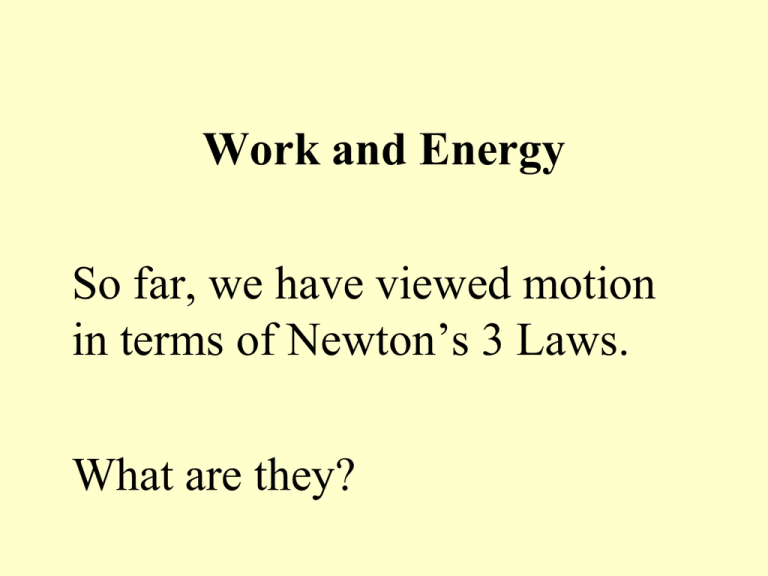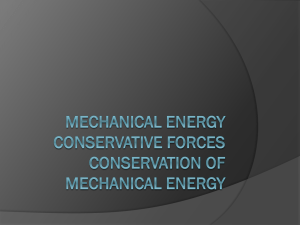Work Energy - Red Hook Central School District
advertisement

Work and Energy So far, we have viewed motion in terms of Newton’s 3 Laws. What are they? • Law of Inertia – a body at rest stays at rest & a body in motion continues in its straight line motion at a constant v unless a net external force acts on it. Law of Acceleration -An Fnet will cause a mass to accelerate F = ma. Action- Reaction - If a force is applied to a particle by a body, the particle will apply an equal but opposite force to the body. Work, Power, & Energy Energy, E offers an alternative analysis of motion and its causes. Changes in E is valuable in analyzing motion in systems i.e. roller coasters, engines, power plants, transformers. What are some types of energy? What is energy? Define it. Def: Energy is ability to do work. Work is done when force applied to an object or particle causes motion parallel to force direction. Work and Energy are Scalar quantities. W = F net x d cosq. • F = parallel l l to displacement N. • q = angle between force and displacement. • q = 0, W = Fd. . . • d = displacement – m. • If Fap has no component parallel to motion W=0! • Remember Fnet = S F, if more than 1parallel force, they add. Units W = Fd = (N m) kg m m . s2 kg m 2. s2 Joules (J) • When a force F is applied to an object, it may produce a displacement d. W = F d = F d cos () Work can be zero even if force is applied. W = Fd cos a • The work done is zero if: – d = 0 m (no displacement) – force perpendicular to the displacement. Work is Scalar but: Work is positive when the force component causing the displacement is in the same direction as the displacement. Work is negative when the force component causing the displacement is in the opposite direction as the displacement. Zero Work • There are many important examples of forces that do not do any work. • For example, the gravitational force between the earth and the moon does not do any work! Moving horizontally while applying an upward force is not work. Yeah – right!! Examples • How much work is done to lift a 10 N chair 1 meter? W = Fd 10N x 1m 10-J • How much work is done to hold a 44 N weight at a constant height of 2.0 m? W = Fd 44N x 0 W=0 Forces acting at angles to motion Consider the Force Component parallel to displacement. Ex 1: A man pulls a cart with a rope that makes a 20o angle to the horizontal. If he exerts a 100 N force, how much work is done is he pulls the cart 8.0 meters? W = F cos qd = 100 N (cos 20o)(8.0m) = 752 Nm = 752 J 100 N 20o FII Ex 2. A student lifts a 1.5-kg box 2-m straight up. a. How much work did she do on the box? b. How much work did gravity do on the box? The force on the box was: Fg = mg (1.5 kg)(10 m/s2) = 15-N. The work done by the student was W = Fd (15-N)(2-m) = +30 J. Gravity did negative 30 J of work b/c it was pulling in the opposite direction of the displacement. Hwk: Worksheet “intro work” • Hwk Work Prb’s Text read 168 – 171 • Do 170 all • Pg 193 #2, 3, 4, 5, 7-9. • Hwk Work Prb’s Text read 168 – 171 • Do 170 all • Pg 193 # 3, 4, 5, 7-9. Energy Energy = Ability to do work. Energy is measured in Joules. E measured in terms of amount of work it can do. If a battery has 9 J of E, it can do 9 J of work. Relationship between Work and Energy. • It takes work to change an object’s energy from one form to another, or to increase or decrease it. • What are some forms of energy? Common Energy Types: Kinetic (KE) – energy of motion Gravitational Potential (GPE) – energy due to height in gravitational field. Chemical- energy stored in chemical bonds Elastic Potential – energy stored in shape deformations. Electrical Energy – due to charge separation. Internal or Heat Energy (Q) – due to vibration of atoms. Mass/Nuclear Energy = Stored between subatomic particles. E = mc2. Kinetic Energy, KE is energy associated with object in motion. The amount of KE = ½ mv2. m = mass in kg. v = velocity in m/s. KE in Joules (J) or Nm. Derivation of KE equation. • • • • KE = W KE = FDd KE = maDd KE = m (Dv) Dd = m Dv Dd Dt Dt = m Dv v = m(vf - vi) (vf + vi) where vi = 0 2 KE = ½ mv2. Ex 3: Calculate the speed of a 80,000-kg airplane with KE = 1.1 x 109 J. KE = ½ mv2 v 2 KE / m 9 2 (1 . 1 x10 J ) / 80 , 000 kg = 170 m/s Work must be done to change the E of an object. W = DKE. W = KEf - KEi Ex 3: A pitcher does work to accelerate a 145g baseball from rest to 25 m/s. a) What is its KE? b) How much work was done to reach this speed? KE = 1/2mv2. • a) ½(0.145kg)(25m/s)2 = 45 J • b) since the KE is 45 J and the initial KE was zero: DKE =KEf – KEi DKE = 45 J – 0 J = 45 J of work Work – KE Theorem Wnet = DKE In order to change the velocity of an object (DKE), work must be done. The amount of work done is equal to the change in KE. Ex 4: How much work is required to accelerate a 1000 kg car from 20 m/s to 30m/s? The work needed is equal to the DKE. DKE = KE2- KE1. • W = 1/2mv2f - 1/2mv2i. • =1/2(1000kg)(30m/s)2 -1/2(1000kg)(20m/s)2. = 2.5 x 105 J. Ex 4: On a frozen pond, a person kicks a 10-kg sled giving it an initial speed of 2.2 m/s. It slides and eventually comes to a stop. • How much work is done bringing it to a stop? • What force does work to stop the sled? • How far will the sled move after being kicked if the coefficient of kinetic friction is 0.10 between the ice and the sled? List m = 10kg vi = 2.2 m/s vf = 0 m = 0.1 d=? W = DKE = KEf – KEi W = 0 - 1/2mvi2. W = ½(10kg)(2.2)2.= 24.2 J Friction stops the sled. • W = 24.2 J • Fd = 24.2 J mFnd=24.2 J mmgd = 24.2 J • 0.1(10kg)(9.81m/s2)d = 24.2 J • d = 2.48 m. In the past we’ve used velocity, acceleration equations to solve for distance, velocity etc. We can consider using KE and work equations. • Text Pg 176 #1, 2, 4 and • pg 193 #5-10 12-14. Force/distance Graphs Area under curve = work or DE. Do Now: A constant force is applied over a distance to an object & graphed. How would we calculate work from the graph? Find the work done at 8-m. What if the force is not constant but varies over distance? How would we find the work done from the graph? ½ (4mx5N) = 10 Nm Find the work done between 4 – 8m. Wtot = 20+10=30 Nm 4mx5N = 20 Nm How much work between 8 – 14 m? • 25J Potential Energy – Stored Energy An object can store energy as the result of its position. Gravitational Potential Energy (GPE or PEg) Energy due to position of object above some base level (lowest available point). PEg = work done to raise some distance against gravity. W = Fd W = mgd PEg = mgDh Examples of work done by GPE Pile driver Dam or waterfalls See Saw Circus Act. Ex 2: A 12 N weight fell 2-m. How much PE did it lose? What agent did work on the weight? Was the work positive or negative? PE = (mg) h (12N)(2m) = 24 J Positive F and d same As objects fall under gravity, they lose PEg but gain KE. (They go faster) Ex 3: A 50 N weight falls for 10-m. How much PE does it lose? • 50N x 10m = 500 J How much KE does it gain? • 500 J What is its velocity at that point? • KE = ½ mv2. • 500J = ½ (5kg) v2. • 14 m/s. Elastic PE Elastic materials store energy when stretched or compressed. The further they are deformed, the more E they will store (the more work they can do). It takes a force to stretch or compress a spring. Each spring has a constant, k, which indicates how much force is needed to deform it. Hooke’s Law • How much force is needed to deform elastic material. • Hooke’s Law – Fs = kx. • Force on spring, N (=weight), • x is DL (m), • k is constant in N/m. Ex 4: A 12-N weight stretches a spring 25cm when hung from it. What is k for the spring? • F = kx • F/x = k • 12-N/0.25m = 48 N/m. Graph F vs. x is direct linear Fs = kx. Slope = k Elastic Energy PEs. • PEs= ½ kx2. – x is the dif btw relaxed length and new length in meters sometime Dx. – k is a constant for the material N/m. – PE in joules. Ex 5. A 2.0 kg mass is attached to a vertical spring, the spring is stretched 10.0 cm such that the mass is 50.0 cm above the table. 1. What is the GPE relative to the table? 9.81 J 2. What is the spring’s PEs if k = 400.0 N/m? 2.0 J 3. What is the total PE of the system? 11.8 J Ex 6: A spring with a force constant of 5.2-N/m has a relaxed length of 2.45-m. When a mass is attached to it the vertical length of the spring is 3.57-m. Calculate the PEs stored in the spring. 3.3 J 7. A spring has a constant of 500 N/m. What is the work required to compress it 3.0-cm? • • • • W = DPEs W = ½ kx2. =1/2 (500)(0.03m)2. W = 0.225 J Derive the PEs equation. Energy is area under curve for F vs. x graph. Area = E or W W=½Fx But Fs = kx so W = ½ (kx) x E = ½ k x 2. Hwk: Rev Bk Read pg 169-171 Do Pg 173 # 1 - 14, 21-23 Separate Sheet. Mechanical Energy & Nonmechanical Energy Mechanical Energy =KE, GPE, EPE. Non-mechanical/ Internal = heat, light, chemical, nuclear, magnetic, electric, sound. If no E is lost to non-mechanical, then Conservation of Mechanical Energy. Before After S Mechanical Energy = S Mechanical Energy KE 1 + GPE 1 + EPE 1= KE 2 + GPE 2 + EPE 2. Energy Transformations What are the energy transformations in the following situations? • Tossing a ball into the air and catching it. • Bouncing a ball on the floor. • Driving a car into a brick wall. Calculations Using Conservation of Energy • Identify the energy/work transformations. • Set up equalities. • Break down equations if necessary. Common Conservation Concepts • S E constant at every point in system. • If ball has 100-J PEg at 2-m is dropped from rest, how much Etot does it have at 1-m? • 100-J • How much KE does it have a 1-m? • DPEg = KE or • PEg lost = KE gained. • 50-J • W done on system = D E. • If ball gains 150-J PEg by being raised up, how much work was done to raise it? • 150-J Ex 1: A small 10 g (0.01 kg) ball is held to a slingshot stretched 6.0 cm. The spring constant is 200 N/m. It is released and allowed to rise to its highest point. a. What are the energy transformations? PEs KE PEg b. What is the PEs before it is released? 1/2kx2 = 0.36J c. What is the KE of the ball just as it leaves the slingshot? PEs lost = KE gained = 0.36J d. What is the ball’s speed at that instant? KE = 0.36J = 1/2mv2 v = 8.5 m/s e. How high does the ball rise if it is shot directly upward? KE lost = PEg gained 0.36J=mgh h= 1.5m Ex 2. A bike rider approaches a hill at a speed of 6.1 m/s. The mass of the bike and rider is 95 kg. • What are the E transformations as it coasts uphill? • How high can it coast up the hill? Ignore friction. • • • • ½ mv2 = mgDh v2/2g = h (6.1m/s)2 /2(9.81 m/s2) h = 1.9 m. Ex 3. An apple of mass 1.47 kg is dropped by a student to the ground. If the apple’s velocity a moment before hitting the ground is 5.42 m/s, from what height was it dropped? ~ 1.5 m Ex 4. A skier starts from rest at the top of a 45 m high hill. He skis down the hill which is at a 30o incline, down into a valley, and coasts 40m up to the top of the next hill. • How fast is he going at the valley bottom? Ignore friction. • What is his speed at the top of the 2nd hill? How fast is he going at the valley bottom? 45-m • • • • • 40-m At top all PEg, at bottom all KE. PEgi = KEf. mgDh = ½ mv2. gDh = ½ v2. v = 30 m/s. What is his speed at the top of the 2nd hill? • • • • • • On hill 1 he has only PEg . On hill 2 he has both PEg and KE. PEg lost = KE gained. PE1 – PE2 = KE. mgDh = ½ mv2. 45-m 2 gDh = ½ v . • (9.81 m/s2) (45-40)m = ½ v2. • v = 9.9 m/s. 40-m Ex 5: An archer puts a 0.3 kg arrow to the bowstring. She exerts an average force of 201-N to draw the bowstring back 1.3-m. • What is the speed of the arrow as it leaves the bow? W = E = DKE 261.3 J = DKE =½ mv2 Fd = (201 N)(1.3m) = 261.3 J 42 m/s • If the arrow is shot straight up, how high will it rise? W = DPEg 261.3 J = DPE =mgDh h = 90 m Pendulum Problems PE to KE to PE Compare the PE & KE at the top & bottom of the swing. • Top KE =0 • PEg maximum • Bottom of swing PEg = 0 • KE is maximum Ex 6. A 0.4-kg pendulum bob has 10-J of PEg at the top of its swing. • What is its KE at the bottom of the swing? • What is its velocity at the bottom? • What is its velocity when it is halfway between the top and bottom? • • • • 10-J 10-J = ½ mv2 v = 7.1 m/s. 5 m/s. v2 = 50 Hwk read Txt 5-3 do pg 185 1, 2, 5 and Pg 195 #33, 38, 39, 50, 57, 59 Show all equations, work, units, circle answers. Counts for double hwk due D4 (Tuesday) Roller Coasters Safari Film Clip “Physics of Fun” 23 min • While you watch: • List any physics concepts we’ve covered. • Give as many examples of how they’re used in “fun” as you can. • List physics concepts that are new. • Give examples of those. Power Def: Rate at which work is done. Power = work/time = W t J s Nm s 1 J/s = 1 Watt (W) If it takes 10 seconds to do 50 J of work, then P = 50J 10s 5 J/s or 5W. Power is related to speed that work gets done. Watts are commonly used to describe how fast motors & engines will do work. P=W t Fd t Fv 1 watt is the rate at which a 1N force does work if it moves a body 1m/s. 1 horsepower (HP) = 746 watts. Ex 2: A motor exerting a steady force of 10N on an object keeps the object moving forward at 2m/s. What is the power of the motor? P = Fv P = (10N)(2m/s) = 20 Nm = 20 W. s Ex 3: An engine exerts a force 1000 N and expends 12 kW of power to keep a car moving at constant speed. What is the car’s velocity? P = Fv v = P/F 12 kW = 12,000 W = 12,000 Nm/s So 12,000Nm/s = 1000 N 12 m/s Hwk: Text pg 187 – 189 Do Prac Prb 189 #1, 3-5, and Sec Review PRb #1-3. Energy Lost to Friction (or other internal forms) • Often Mech. E is converted to heat because of friction or can be converted to other forms of internal E like sound. • Think about a box being pushed on the ground at a constant velocity by an applied force of 20-N. What force is friction exerting on the box? Ex 1. A girl pushes a box at a constant speed 10-m by doing 15-J of work. How much work was done by friction? Hint: Sketch the free body diagram. • 15 J • If some ME is “missing” after your calculations are done, it was probably “lost” to frictional heating. • The “lost” ME is the difference between the the total initial ME the total final ME. • Set up an energy transformation equation and take the difference between the two energies. Ex 2. A 5 kg box slides down a hill from a height of 6-m. If its KE at the bottom of the hill is 200-J, how much energy was lost to friction? • PE = mgh should equal gain in KE • =(5kg)(9.81m/s2)(6m) • =294 J but KE only 200J 294 J – 200 J = 94 J Lost Ex 3: A workman uses a pulley to raise a 12-N box 12-m. If he does 200-J of work in raising the box, how much energy was lost to friction? • 200 J – 144 J . • 56 J Energy & Work Something for Nothing? Why do people use a ramp rather than steep stairs to push a box or shopping cart? • If a box gains 4 J of GPE, it takes 4 J of work to give it the GPE regardless of whether you lift it straight up or push it up a (frictionless) ramp! Consider sliding a box up a ramp to change its PEg. force you apply is to overcome the weight. (no friction). As the ramp angle gets lower the distance to raise the object must get longer to attain the same DPE. So F gets less, d gets proportionally longer. For the same DPE, the distance can be shorter or longer. But work Fd is the same. Either large F & short d, or small F & long d. Dh1 d1 Dh1 Dh2 d2 Dh2 Hwk Packet. Efficiency IB only Usually, some energy is lost to heat, light, sound, etc. We must do extra work. Efficiency is a percentage: useful work done x 100% actual work done Ex 4 reg: An engine with a power output of 1.2 kW pulls an object with weight of 1000 N at a constant speed straight up. A constant frictional force of 300 N acts on the engine. The object is lifted a distance of 8.0 m. 1.Find the speed of the object . 2.the efficiency of the engine. Ex 4: An engine with a power output of 1.2 kW drags an object with weight of 1000 N at a constant speed up a 30o incline. A constant frictional force of 300 N acts between the object and the plane. The object is dragged a distance of 8.0 m. 1. Find the speed of the object and the efficiency of the engine. 2. calculate the energy output per second of the fuel used. Speed of the Object The downhill weight component is: 1000 N (sin 30o) = 500 N. The total force the engine must overcome is weight + friction: 500 N + 300 N = 800 N. P = Fv v=P F 1200 W 800 N v = 1.5 m/s. The machine lifts the weight to a height: 8.0m (sin30o) = 4.0 m. The useful work is (mg)h: (1000 N)(4.0 m) = 4000 J. The actual work done is: (800 N)(8.0m)= 6400 J. Eff: useful work x 100% actual work 4000 J x 100% 6400 J =63 % You can calculate the energy output per second of the fuel used. Since the machine has a power output of 1.2 kW and is 63% efficient, the fuel must produce energy at a rate of: 1.2 x 103 J/s = 1.9 x 103 J/s. 0.63 Work done by non-constant force. Area under curve of F vs d = work done W = Fd = ½ kx2.






